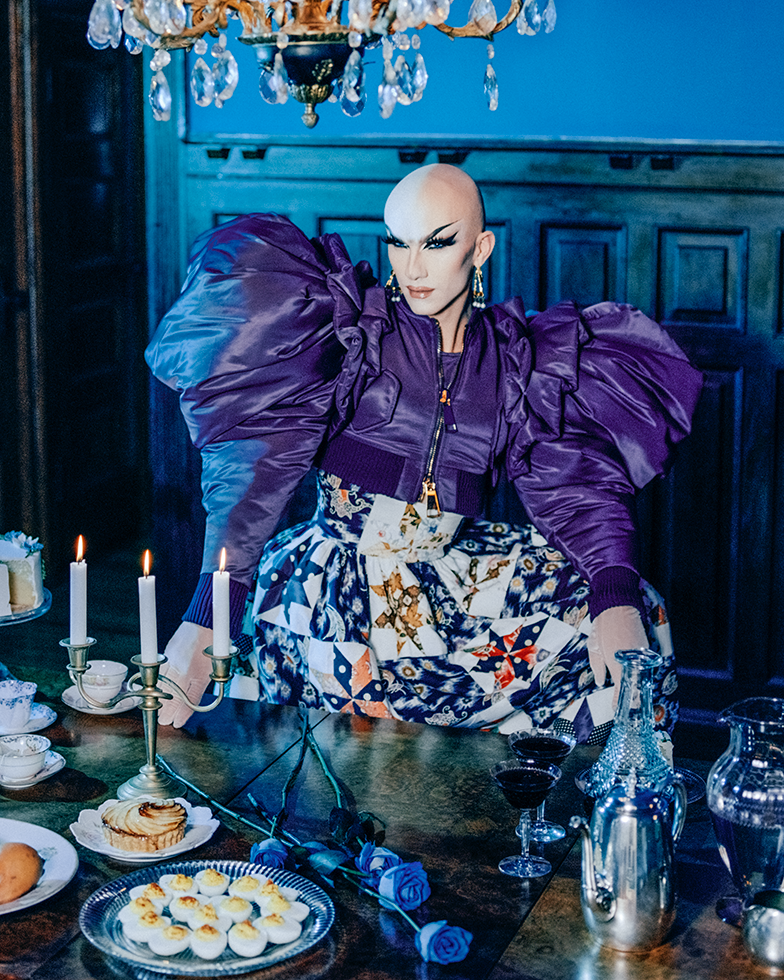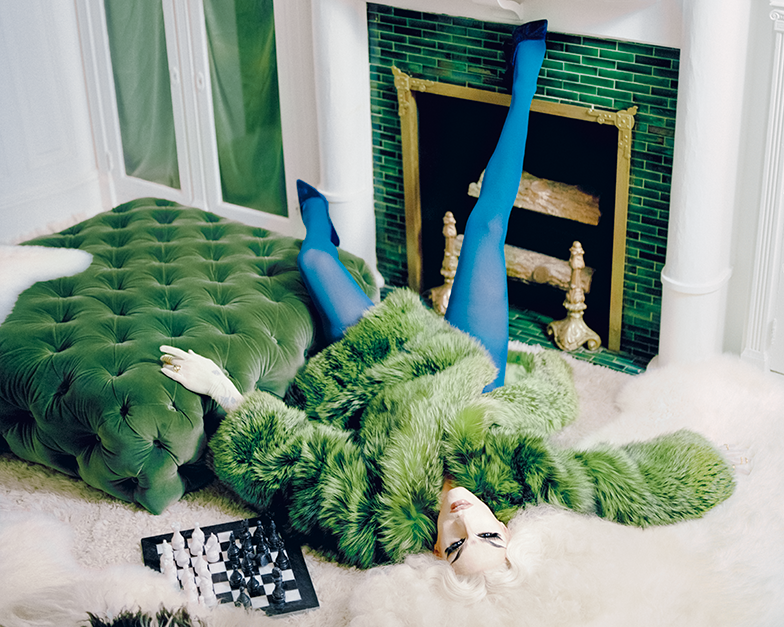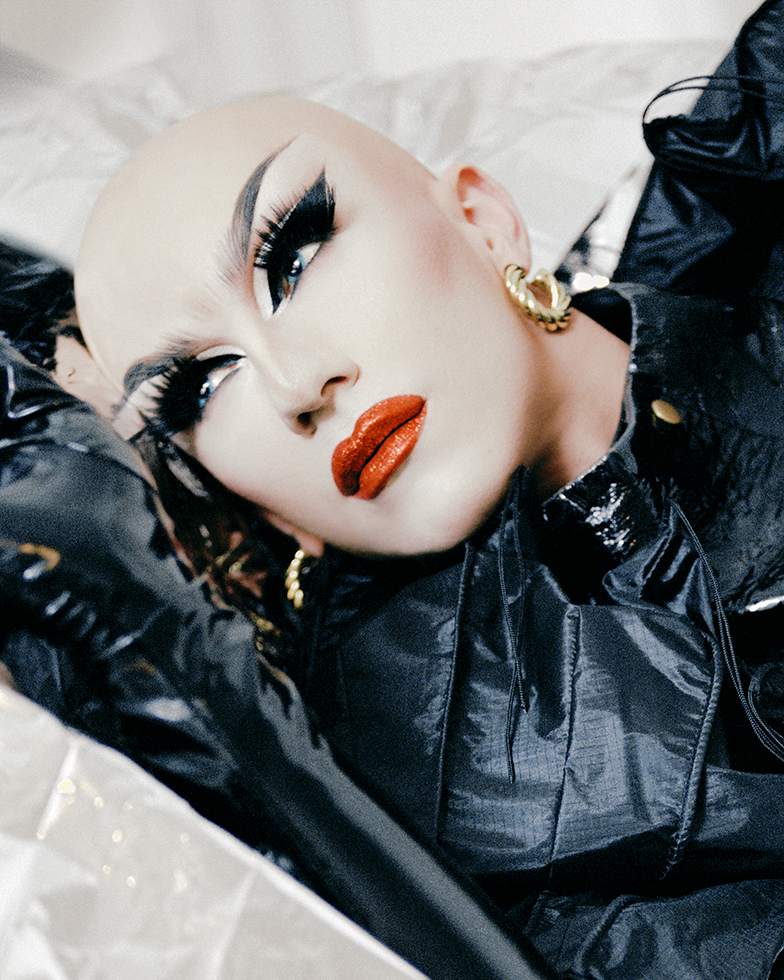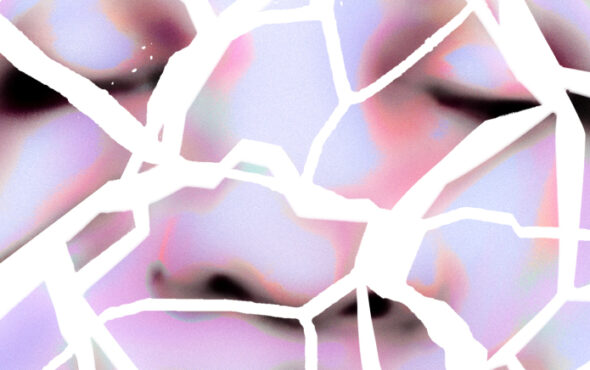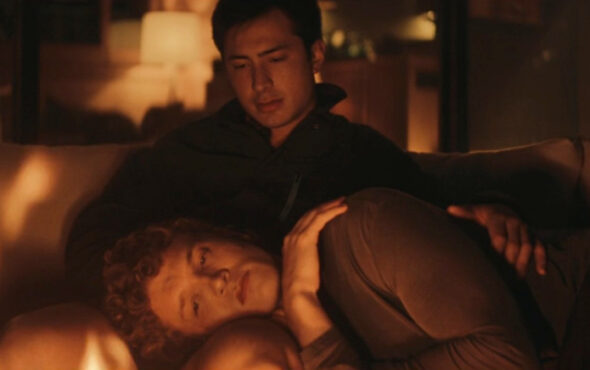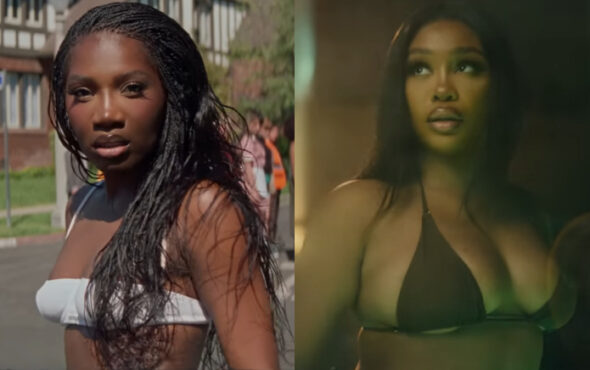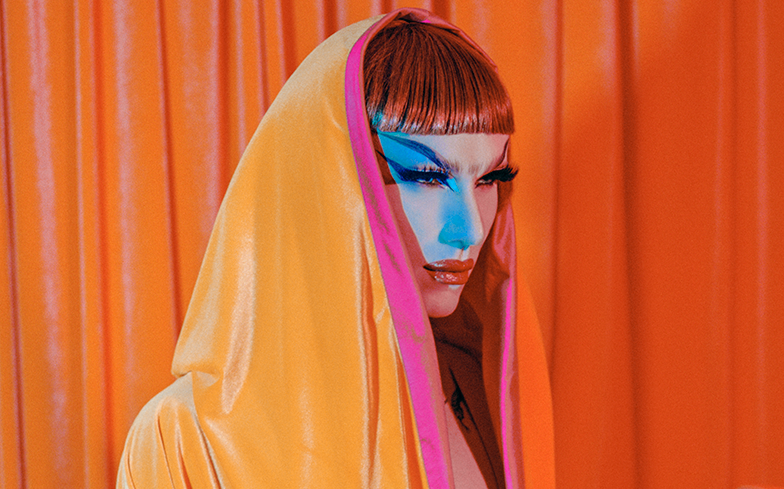
In conversation with Alok Vaid-Menon.
It’s been two years since Sasha Velour became the eleventh crowned queen of RuPaul’s Drag Race (including All Stars) and left the world positively gagged with their rose-petal extravaganza. Since then, the New York-based performer has used their platform to create safe spaces for the LGBTQ community and to represent queer advocacy in entertainment. Last year, Sasha was signed by global celebrity talent agency William Morris Entertainment after speaking at the Teen Vogue Summit, and later became the creative director for the opening show of New York Fashion Week. They then published their own coffee table art book, Velour: The Drag Magazine, which comprises of poetry, essays, history, queer theory, magic and a sickening photo series.
In celebration of Sasha’s first solo show, Smoke and Mirrors, performance artist and writer Alok caught up with the Drag Race champion to discuss their beloved NYC drag show, Nightgowns, the importance of bringing historical references to drag in contemporary spaces, and what it would mean for the art of drag if we were to successfully deconstruct gender.
Alok: Sasha! Last time I saw you was at my first Nightgowns show… at Terminal 5 nonetheless. I spent the entire show transfixed by your magic. It feels fitting to start with something so near and dear to your heart. Can you tell us more about how Nightgowns came to be?
Sasha: Thank you, Alok! Nightgowns grew out of a zine I created with my partner Johnny called Velour: The Drag Magazine. In 2013, when we started, I knew more about illustration and design than I did about makeup or costume, so I filtered my drag through self-publishing! The first issue was a short stapled zine assembled in two months, featuring interviews, poetry, and art pieces exploring the history and diversity of drag, with a focus on local communities, drag kings, and trans and AFAB performers. We sold out in our first weekend at the Small Press Expo in Bethesda, outside DC. By 2015 we had raised enough money to publish an offset-printed, perfect-bound version of Issue 1, now 100 pages, featuring art from around the country. It was the biggest accomplishment of my life! We decided to host a launch party when the printed books arrived in the mail, initially just to gather the contributors and distribute the beautiful copies, but it ended up being quite a cute ramshackle drag show. Most importantly, we packed in a crowd on a usually quiet Thursday night at a local bar called Bizarre! The owners of Bizarre loved it so much, they asked me to do a show every month… and that was the birth of Nightgowns. From the beginning, I’ve always viewed my role as the show’s host to be pretty similar to my role as magazine editor. In both cases my task is to put together a line-up that’s entertaining, eye-opening, and representative… and then to give the artists the proper formatting and presentation for their work. For the magazine, I do all the layout and retouching so that everyone looks good; for Nightgowns I do the lighting and stage design. At first I had no idea what I was doing… we used flashlights as follow spots! But at least I know I’m driven and passionate about putting out a high-quality product for my people, and that’s definitely carried through to today. Hours before the Terminal 5 show, I was in the booth rehearsing cues with the lighting designer; I’m a notorious perfectionist about how drag performers are supposed to be lit!
Sasha wears blazer by JunJie; earrings by John Hardy; ring by Chris Habana; trousers and shoes are Sasha’s own
A: I loved how you used the night to feature local queer/trans performance artists alongside you like Untitled Queen and Lady Quesadilla. So often we’re used to seeing drag as hyper-competitive and individuated, but I’ve always respected your artful pivots: how you find a way to dilate your spotlight to highlight other artists as well as political issues facing our community. How has queer community shaped you as a person and a performer?
SV: I believe that you can’t even really understand drag through the lens of a single performer. Drag is defined only by radical and ever-expanding possibility…by the diversity of genders, bodies, and imaginations displayed on a single stage, and by the audience’s ability to appreciate it all at once. In order to faithfully celebrate drag, you must feature many different figures and voices in the spotlight. Not that competition is completely alien to drag… I’m sure queens and kings have been trying to out-do each other’s looks and stunts since Molly Houses in London in the 1700s or the first Harlem drag balls in the 1860s. But I still think the phenomenon of drag performers helping each other succeed as a community is far more significant historically, and it’s way more interesting to me personally! After all, that’s the story behind Stonewall, Wigstock, Ball and Pageant Culture, even Pride itself. Not for nothing, but the reason that drag is having such a moment right now isn’t because of a single TV show or a couple well-known performers… it’s because of how the community as a whole has taken to the art-form and run wild with it… I want to see more platforms address and document that reality.
Sasha wears dress and hat by Christopher John Rogers; gloves by Wing & Weft; earrings by Chris Habana
A: One of the things that really stood out to me about the show was how you curated drag queens alongside drag kings and represented performers of various genders. Unfortunately, as we both know, this is an anomaly in the drag world. Can you speak a little bit about the importance of a more expansive understanding of drag?
SV: Whenever drag gets marketed to mainstream audiences, the focus gets put on “men dressed as women” or “women dressed as men.” I think about the Jewel Box Revue that toured the US from the 30s through the 60s, advertised as “25 men and 1 girl” (the 1 girl, of course, being Storme DeLarverie, the drag king who many claimed threw the first punch at Stonewall). So the connection of popular drag with cis men (mostly white) is nothing new. But it’s always been a different story within queer-run drag circles. Where I grew up in central Illinois, for example, drag shows were full of trans showgirls, drag kings, and AFAB queens long before Drag Race even existed. There were times in history when drag kings were more popular than queens. A town in Japan called Takarazuka became famous in the 10s and 20s for drag king performances that supposedly would break young women’s hearts. During the 1890s, drag kings like Vesta Tilley toured the world’s vaudeville circuits decades before queens like Julian Eltinge or Bert Savoy got such a break. Throughout history, drag has been everything— good, bad, male, female, utopian, problematic, queer, straight, cis, trans, and so on—any attempt to define it narrowly runs aground of the facts. An expansive and evolving understanding is really the only option.
Sasha wears jacket and dress by Viktor&Rolf; earrings by Chris Halbana; gloves by Carolina Amato
A: I know we both love theory. I’m curious: if we were to successfully deconstruct gender, what would this mean for the art of drag?
SV: Oh I fantasize about the day! If our culture was able to uncouple itself from binary gender, I think more audiences would turn to drag for entertainment. After a while, it gets boring watching the same expressions of gender play out in movies and books and TV. I think once you stop investing in being perceived as a “normal” man or a “normal” woman yourself, you lose interest in watching other people do it too. And I imagine that would affect what kind of drag succeeds. Right now, people are still most comfortable with familiar articulations of gender and beauty, even when it comes to drag. I hope a queerer audience would value excitement and variety even more, and put even less stock in “realness.”
Sasha wears jacket by Adrienne Landau; gloves by Carolina Amato; tights and shoes are Sasha’s own. Ottoman by Article Furniture.
A: Getting to know you over this past year has shown me that you’re not just a reality TV star, you’re a visual artist, queer theorist, and visionary curator. So often people try to pin-down things that are constantly in flux – gender, art, public personalities. What is the biggest misconception about Sasha Velour? Who is Sasha Velour on your own terms? How is she ever-evolving?
SV: You honor me too much Alok! But if I’m honest, I can’t really see myself as any of those things… and I think that’s exactly your point. As much as I enjoy trying to define Sasha Velour day to day, in a sense her entire purpose in my life is to remain indefinable… an ongoing and evolving project, a reminder that reinvention is always possible. The biggest misconception about Sasha Velour is that you can get a good sense of who she is from watching Drag Race. Even though I had so much fun finding solutions to the challenges thrown our way on television, you really don’t get to see “Sasha Velour-style” drag without coming to see Nightgowns, or even just watching me perform my own numbers. Also it’s been over two-and-a-half years since filming season nine episode one, I’ve worked almost every day since, so I consider myself a much more professional and experienced entertainer today, thank goddess! I’ll always be a performer. I love to move and emote and do magic onstage, but the work I’m most excited about right now is more behind-the-scenes. I’m interested in developing and perfecting different platforms for showcasing drag, and different rights and representations for drag performers. I think I’m in a unique position where I can make positive change for many different people in the industry, and I want to do everything I can. I hope that in a few years I can help produce large-scale fair-wage drag and queer productions, and advance conversations about unionization and standards for drag.
Sasha wears jacket by Ronald van der Kemp; earrings by Laura Lombardi
A: Speaking of your work beyond the stage: you’ve been publishing Velour: The Drag Magazine since 2013 and recently released a hardcover coffee table book, that I actually have on my table at home. It’s so magnificently laid out, congrats! It seems that with the digitization of everything we are losing so much print culture. What I see in your work is an argument for so many things that are being dismissed: history, nightlife, the ephemeral. What’s it been like producing this magazine? Why are queer archives like this so important?
SV: I’m so proud of Velour: The Drag Magazine! I do the layout myself, and adjust literally every letter until it’s perfect. I actually learned those skills from my mom. She was a copy-editor for a press, and taught me how to read and adjust a page for clarity, mistakes, and formatting. She even proofread the first full issue of Velour in the final month of her life. I learned from her that even though it adds time to put in such care, the results leave a stronger impact. It’s hard to say what will stand the test of time… In a few generations, today’s fast online imagery and videos may be as discarded and hard-to-find as 90s zines and newsletters are today. Because so much of queer culture happens outside of mainstream visibility, I worry that it does get disposed of, and that young people don’t get to benefit from the brilliance of previous generations. I certainly think that has happened in the world of drag, where significant performers like Mario Montez, Ethyl Eichelberger, and Kevin Aviance aren’t properly appreciated or studied today. I think that’s why I’m so intense about building my own archive of drag. I want to make sure the amazing artists around me will be documented and preserved for the future. And it’s not just with Velour; almost every performance of Nightgowns since the move to National Sawdust has been filmed for the archives.
Sasha wears jacket by Adrienne Landau; hat by J. R. Malpere; glasses and earrings by ISLYNYC; ring by Chris Habana
A: And while we’re on the future, you’ve just debuted your one-woman show Smoke & Mirrors in Australia! I can’t wait to watch it when it comes home. Can you tell us more about this show and what we can expect?
SV: Yes! I finally took a few months and put together a full-length show of my own work. Prior to Drag Race, my specialty in Brooklyn was putting on multimedia drag shows, with wild projections, posters, and soundtracks. Unfortunately, because of the limitations of most Drag Race-themed touring, I haven’t been able to share those kinds of performances on the road. Smoke & Mirrors is my first fully “Velourian” theater take-over! I guess I’d describe it as a 75-minute magic show with amazing non-binary fashions, gag-worthy stunts, and some deep personal insights sneaking in around the edges. I’m really thankful that In The Dark in Australia allowed me to develop a true theatrical production, this is the most artistically fulfilled I’ve felt in a long time. I plan to bring this show to every country in the world if I can. I’m really keen on producing more shows myself. No one knows how to put on a show quite like a drag queen, darling!
Photography Stevens Añazco
Creative Direction Sasha Velour
Art Direction Yanni Peña
Fashion Yanni Peña


